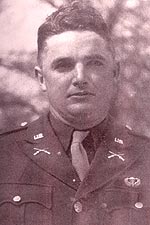I recently finished Stephen Ambrose’s Citizen Soldiers about World War II. It’s an interesting read throughout, but my absolute favorite story comes from the introduction. Ambrose describes the Lieutenant Waverly Wray of Company D, 505th Parachute Infantry Regiment, 82nd Airborne Division, commanded by Colonel Ben Vandervoot.
After jumping into Normandy, he began crawling through the sunken lanes to reconnoiter the German positions surrounding them. He came upon a group of eight German officers surrounding a radio — officers who turned out to be leading the counterattack. Wray jumped through the hedgerow and ordered them to surrender.
Seven instinctively raised their hands. The eighth tried to pull a pistol from his holster; Wray shot him instantly, between the eyes. Two Germans in a slit trench 100 meters to Wray’s rear fired bursts from their Schmeisser machine pistols at him. Bullets cut through his jacket; one cut off half of his right ear.
Wray dropped to his knee and began shooting the other seven officers, one at a time as they attempted to run away. When he had used up his clip, Wray jumped into a ditch, put another clip into his M-1, and dropped the German soldiers with the Schmeissers with one shot each.
Wray made his way back to the company area to report on what he had seen. At the command post he came in with blood down his jacket, a big chunk of his ear gone, holes in his clothing. “Who’s got more grenades?” he demanded.
…
Vandervoot later recalled that when he saw the blood on Wray’s jacket and the missing half-ear, he had remarked, “They’ve been getting kind of close to you, haven’t they Waverly?”
With just a trace of a grin, Wray had replied, “Not as close as I’ve been getting to them, Sir.”
Ambrose’s Band of Brothers (on which the HBO series of the same name was based) is more compelling overall, but because it tells the story primarily of a single company of paratroopers it necessarily offers a limited view of the war. Citizen Soldiers gives a more complete overview, but naturally at the cost of some finer detail. Clearly the only reasonable plan is to read both.
The picture of Lt. Wray comes from The U.S. Airborne During WW II, which came up in a Google search for Wray’s name, and which I now must absolutely explore in greater depth.

What’s especially engaging about the telling of Citizen Soldier is that contemporary U.S. forces are volunteer. Or put another way, they are not draftees or short-timers. They are professional warriors. We will not see again an army of people plucked out of everyday life into battle. (The National Guard comes close, but tends to be support services rather than front-line troops.)
The longer term enlistments of today let us train better, use complex technology and techniques, minimize casualties. They also mean soldiers are more likely to be married, have civilian sector skills.
And — I think this is important — today’s military is less like the America it serves. Obviously military forces are mostly male, mostly young. But they are also mostly rural, Southern and Republican. Our nation would be better served by a broader demographic. Military experience — its risks, rewards, costs — would be visible to more citizens. And the decision to go to war would have greater resonance throughout the land.
One of the characteristics of World War II that’s been drawing me back to it a lot lately is that it’s composed almost entirely of things we’ll never see again. The sky won’t be filled with bombers crawling past their targets, the sea won’t be filled with troop carriers easily taken out by missiles or nuclear weapons, and military success will probably never again be drawn on a map.